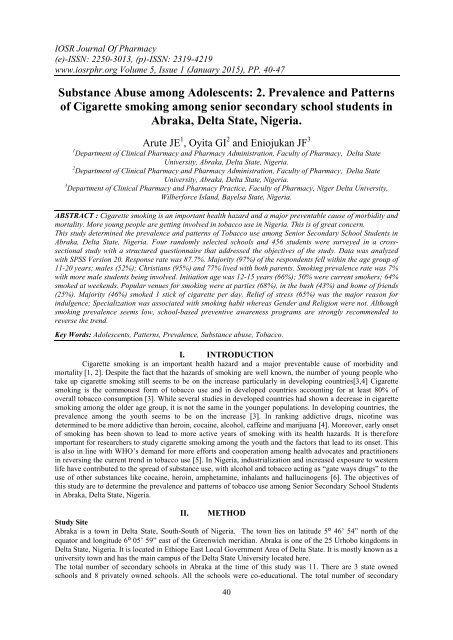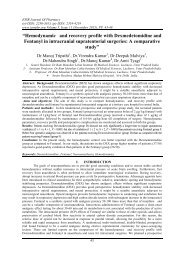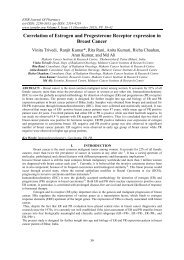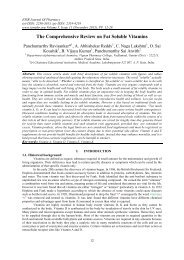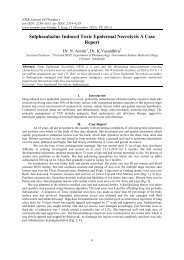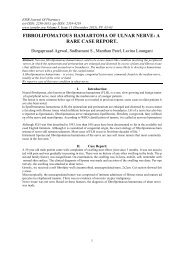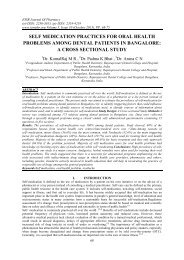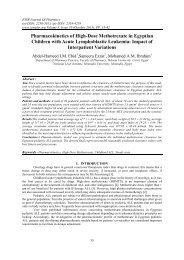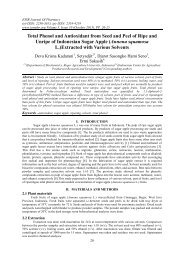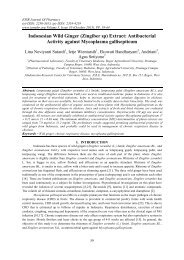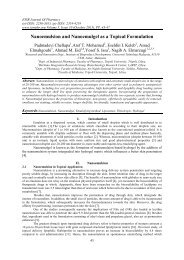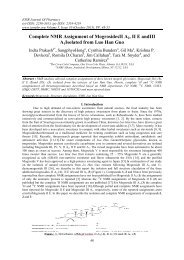Substance Abuse among Adolescents: 2. Prevalence and Patterns of Cigarette smoking among senior secondary school students in Abraka, Delta State, Nigeria.
Create successful ePaper yourself
Turn your PDF publications into a flip-book with our unique Google optimized e-Paper software.
IOSR Journal Of Pharmacy<br />
(e)-ISSN: 2250-3013, (p)-ISSN: 2319-4219<br />
www.iosrphr.org Volume 5, Issue 1 (January 2015), PP. 40-47<br />
<strong>Substance</strong> <strong>Abuse</strong> <strong>among</strong> <strong>Adolescents</strong>: <strong>2.</strong> <strong>Prevalence</strong> <strong>and</strong> <strong>Patterns</strong><br />
<strong>of</strong> <strong>Cigarette</strong> <strong>smok<strong>in</strong>g</strong> <strong>among</strong> <strong>senior</strong> <strong>secondary</strong> <strong>school</strong> <strong>students</strong> <strong>in</strong><br />
<strong>Abraka</strong>, <strong>Delta</strong> <strong>State</strong>, <strong>Nigeria</strong>.<br />
Arute JE 1 , Oyita GI 2 <strong>and</strong> Eniojukan JF 3<br />
1 Department <strong>of</strong> Cl<strong>in</strong>ical Pharmacy <strong>and</strong> Pharmacy Adm<strong>in</strong>istration, Faculty <strong>of</strong> Pharmacy, <strong>Delta</strong> <strong>State</strong><br />
University, <strong>Abraka</strong>, <strong>Delta</strong> <strong>State</strong>, <strong>Nigeria</strong>.<br />
2 Department <strong>of</strong> Cl<strong>in</strong>ical Pharmacy <strong>and</strong> Pharmacy Adm<strong>in</strong>istration, Faculty <strong>of</strong> Pharmacy, <strong>Delta</strong> <strong>State</strong><br />
University, <strong>Abraka</strong>, <strong>Delta</strong> <strong>State</strong>, <strong>Nigeria</strong>.<br />
3 Department <strong>of</strong> Cl<strong>in</strong>ical Pharmacy <strong>and</strong> Pharmacy Practice, Faculty <strong>of</strong> Pharmacy, Niger <strong>Delta</strong> University,<br />
Wilberforce Isl<strong>and</strong>, Bayelsa <strong>State</strong>, <strong>Nigeria</strong>.<br />
ABSTRACT : <strong>Cigarette</strong> <strong>smok<strong>in</strong>g</strong> is an important health hazard <strong>and</strong> a major preventable cause <strong>of</strong> morbidity <strong>and</strong><br />
mortality. More young people are gett<strong>in</strong>g <strong>in</strong>volved <strong>in</strong> tobacco use <strong>in</strong> <strong>Nigeria</strong>. This is <strong>of</strong> great concern.<br />
This study determ<strong>in</strong>ed the prevalence <strong>and</strong> patterns <strong>of</strong> Tobacco use <strong>among</strong> Senior Secondary School Students <strong>in</strong><br />
<strong>Abraka</strong>, <strong>Delta</strong> <strong>State</strong>, <strong>Nigeria</strong>. Four r<strong>and</strong>omly selected <strong>school</strong>s <strong>and</strong> 456 <strong>students</strong> were surveyed <strong>in</strong> a crosssectional<br />
study with a structured questionnaire that addressed the objectives <strong>of</strong> the study. Data was analyzed<br />
with SPSS Version 20. Response rate was 87.7%. Majority (97%) <strong>of</strong> the respondents fell with<strong>in</strong> the age group <strong>of</strong><br />
11-20 years; males (52%); Christians (95%) <strong>and</strong> 77% lived with both parents. Smok<strong>in</strong>g prevalence rate was 7%<br />
with more male <strong>students</strong> be<strong>in</strong>g <strong>in</strong>volved. Initiation age was 12-15 years (66%); 50% were current smokers; 64%<br />
smoked at weekends. Popular venues for <strong>smok<strong>in</strong>g</strong> were at parties (68%), <strong>in</strong> the bush (43%) <strong>and</strong> home <strong>of</strong> friends<br />
(25%). Majority (46%) smoked 1 stick <strong>of</strong> cigarette per day. Relief <strong>of</strong> stress (65%) was the major reason for<br />
<strong>in</strong>dulgence; Specialization was associated with <strong>smok<strong>in</strong>g</strong> habit whereas Gender <strong>and</strong> Religion were not. Although<br />
<strong>smok<strong>in</strong>g</strong> prevalence seems low, <strong>school</strong>-based preventive awareness programs are strongly recommended to<br />
reverse the trend.<br />
Key Words: <strong>Adolescents</strong>, <strong>Patterns</strong>, <strong>Prevalence</strong>, <strong>Substance</strong> abuse, Tobacco.<br />
I. INTRODUCTION<br />
<strong>Cigarette</strong> <strong>smok<strong>in</strong>g</strong> is an important health hazard <strong>and</strong> a major preventable cause <strong>of</strong> morbidity <strong>and</strong><br />
mortality [1, 2]. Despite the fact that the hazards <strong>of</strong> <strong>smok<strong>in</strong>g</strong> are well known, the number <strong>of</strong> young people who<br />
take up cigarette <strong>smok<strong>in</strong>g</strong> still seems to be on the <strong>in</strong>crease particularly <strong>in</strong> develop<strong>in</strong>g countries[3,4] <strong>Cigarette</strong><br />
<strong>smok<strong>in</strong>g</strong> is the commonest form <strong>of</strong> tobacco use <strong>and</strong> <strong>in</strong> developed countries account<strong>in</strong>g for at least 80% <strong>of</strong><br />
overall tobacco consumption [3]. While several studies <strong>in</strong> developed countries had shown a decrease <strong>in</strong> cigarette<br />
<strong>smok<strong>in</strong>g</strong> <strong>among</strong> the older age group, it is not the same <strong>in</strong> the younger populations. In develop<strong>in</strong>g countries, the<br />
prevalence <strong>among</strong> the youth seems to be on the <strong>in</strong>crease [3]. In rank<strong>in</strong>g addictive drugs, nicot<strong>in</strong>e was<br />
determ<strong>in</strong>ed to be more addictive than hero<strong>in</strong>, coca<strong>in</strong>e, alcohol, caffe<strong>in</strong>e <strong>and</strong> marijuana [4]. Moreover, early onset<br />
<strong>of</strong> <strong>smok<strong>in</strong>g</strong> has been shown to lead to more active years <strong>of</strong> <strong>smok<strong>in</strong>g</strong> with its health hazards. It is therefore<br />
important for researchers to study cigarette <strong>smok<strong>in</strong>g</strong> <strong>among</strong> the youth <strong>and</strong> the factors that lead to its onset. This<br />
is also <strong>in</strong> l<strong>in</strong>e with WHO’s dem<strong>and</strong> for more efforts <strong>and</strong> cooperation <strong>among</strong> health advocates <strong>and</strong> practitioners<br />
<strong>in</strong> revers<strong>in</strong>g the current trend <strong>in</strong> tobacco use [5]. In <strong>Nigeria</strong>, <strong>in</strong>dustrialization <strong>and</strong> <strong>in</strong>creased exposure to western<br />
life have contributed to the spread <strong>of</strong> substance use, with alcohol <strong>and</strong> tobacco act<strong>in</strong>g as “gate ways drugs” to the<br />
use <strong>of</strong> other substances like coca<strong>in</strong>e, hero<strong>in</strong>, amphetam<strong>in</strong>e, <strong>in</strong>halants <strong>and</strong> halluc<strong>in</strong>ogens [6]. The objectives <strong>of</strong><br />
this study are to determ<strong>in</strong>e the prevalence <strong>and</strong> patterns <strong>of</strong> tobacco use <strong>among</strong> Senior Secondary School Students<br />
<strong>in</strong> <strong>Abraka</strong>, <strong>Delta</strong> <strong>State</strong>, <strong>Nigeria</strong>.<br />
II. METHOD<br />
Study Site<br />
<strong>Abraka</strong> is a town <strong>in</strong> <strong>Delta</strong> <strong>State</strong>, South-South <strong>of</strong> <strong>Nigeria</strong>. The town lies on latitude 5⁰ 46’ 54” north <strong>of</strong> the<br />
equator <strong>and</strong> longitude 6⁰ 05’ 59” east <strong>of</strong> the Greenwich meridian. <strong>Abraka</strong> is one <strong>of</strong> the 25 Urhobo k<strong>in</strong>gdoms <strong>in</strong><br />
<strong>Delta</strong> <strong>State</strong>, <strong>Nigeria</strong>. It is located <strong>in</strong> Ethiope East Local Government Area <strong>of</strong> <strong>Delta</strong> <strong>State</strong>. It is mostly known as a<br />
university town <strong>and</strong> has the ma<strong>in</strong> campus <strong>of</strong> the <strong>Delta</strong> <strong>State</strong> University located here.<br />
The total number <strong>of</strong> <strong>secondary</strong> <strong>school</strong>s <strong>in</strong> <strong>Abraka</strong> at the time <strong>of</strong> this study was 11. There are 3 state owned<br />
<strong>school</strong>s <strong>and</strong> 8 privately owned <strong>school</strong>s. All the <strong>school</strong>s were co-educational. The total number <strong>of</strong> <strong>secondary</strong><br />
40
<strong>Substance</strong> <strong>Abuse</strong> <strong>among</strong> <strong>Adolescents</strong>: <strong>2.</strong> <strong>Prevalence</strong>…<br />
<strong>school</strong> <strong>students</strong> <strong>in</strong> <strong>Abraka</strong> is estimated at 10,778 while the total number <strong>of</strong> <strong>senior</strong> <strong>secondary</strong> <strong>school</strong> <strong>students</strong> is<br />
4,178 which is 38.8% <strong>of</strong> the total number <strong>of</strong> <strong>students</strong>. As at study time, two private <strong>school</strong>s were yet to admit<br />
<strong>students</strong> <strong>in</strong>to <strong>senior</strong> <strong>secondary</strong> classes. The study was carried out between February <strong>and</strong> April, 2014.<br />
Study Design<br />
A cross-sectional study design was employed <strong>in</strong> the survey.<br />
Study Population<br />
The respondents were drawn from 4 <strong>senior</strong> <strong>secondary</strong> <strong>school</strong>s that were purposefully selected be<strong>in</strong>g relatively<br />
large <strong>and</strong> popular. These were <strong>Abraka</strong> Grammar School (AGS), Delsu Demonstration School (DDS), Aunty<br />
Rose Group <strong>of</strong> Schools (ARGS), <strong>and</strong> Erhimu Secondary School (ESS)<br />
Study Sample<br />
The sample size was determ<strong>in</strong>ed us<strong>in</strong>g fisher’s formula<br />
N=<br />
Z = St<strong>and</strong>ard normal deviation (1.96)<br />
p = Population <strong>in</strong> the target population estimated to have a<br />
Particular characteristic (<strong>in</strong> this case, prevalence= 0.51) (Abiodun O.A et al, 1994)<br />
q = 1.0 – p<br />
d = degree <strong>of</strong> accuracy required (0.05)<br />
N =<br />
N =<br />
=<br />
= 384 ≈ (400)<br />
The calculated sample size <strong>of</strong> approximately 400 was further <strong>in</strong>creased to 456 to make up for cases <strong>of</strong> attrition.<br />
Respondents were selected by multistage r<strong>and</strong>om sampl<strong>in</strong>g technique. Apply<strong>in</strong>g equal allocation technique, 114<br />
questionnaires were allotted to each <strong>of</strong> the four <strong>school</strong>s. At each <strong>of</strong> the four selected <strong>school</strong>s, the <strong>students</strong> were<br />
first stratified <strong>in</strong>to the three levels – SS1, SS2 <strong>and</strong> SS3. Also, with equal allocation technique, 38 questionnaires<br />
were allotted to each <strong>of</strong> the three levels. Each level was further stratified <strong>in</strong>to Art <strong>and</strong> Science classes <strong>and</strong> 19<br />
questionnaires were allotted to each class.<br />
Consent<strong>in</strong>g <strong>students</strong> were recruited consecutively as they presented till the sample size requirement was met.<br />
Data Collection Tool<br />
A structured questionnaire conta<strong>in</strong><strong>in</strong>g two sections (A <strong>and</strong> B) <strong>and</strong> forty six questions <strong>in</strong> all was used to collect<br />
data. Section A dealt with personal <strong>in</strong>formation like sex, age, class, religion <strong>and</strong> family structure while Section<br />
B conta<strong>in</strong>ed questions on <strong>smok<strong>in</strong>g</strong> habits.<br />
The survey was conducted with<strong>in</strong> a two day period <strong>in</strong> each <strong>of</strong> the selected <strong>school</strong>s, <strong>and</strong> a total <strong>of</strong> 8 visits were<br />
made to the <strong>school</strong>s. The completion <strong>of</strong> the questionnaire was carried out dur<strong>in</strong>g a class hour <strong>and</strong> respondents<br />
were not allowed to confer with one another dur<strong>in</strong>g the exercise<br />
Anonymity was strictly ensured as the respondents were not required to write their names. To further reassure<br />
respondents about confidentiality, only <strong>in</strong>vestigators <strong>and</strong> not class teachers supervised the completion <strong>of</strong> the<br />
questionnaires.<br />
Full explanations were provided for respondents who had problems <strong>in</strong> underst<strong>and</strong><strong>in</strong>g some <strong>of</strong> the questions<br />
after which consent was obta<strong>in</strong>ed.<br />
Validity<br />
41
<strong>Substance</strong> <strong>Abuse</strong> <strong>among</strong> <strong>Adolescents</strong>: <strong>2.</strong> <strong>Prevalence</strong>…<br />
The <strong>in</strong>struments were peer-reviewed <strong>and</strong> also pre-tested to ensure face <strong>and</strong> content validity.<br />
Data Analysis<br />
Data from all four <strong>school</strong>s were pooled together <strong>and</strong> analyzed us<strong>in</strong>g SPSS version 20. Simple frequency tables<br />
were generated as well as cross-tabulation to check for levels <strong>of</strong> statistical significance at p < 0.05.<br />
Ethical Clearance<br />
Permission to conduct the survey was sought <strong>and</strong> obta<strong>in</strong>ed from the <strong>school</strong> pr<strong>in</strong>cipals <strong>and</strong> the <strong>students</strong>.<br />
III. RESULTS<br />
A total <strong>of</strong> 456 questionnaires were collected from the <strong>secondary</strong> <strong>school</strong>s but only 400 were considered<br />
valid for data analysis giv<strong>in</strong>g a response rate <strong>of</strong> 87.7% The socio-demographic Characteristics <strong>of</strong> the espondents<br />
are shown <strong>in</strong> TABLE 1. Majority (97%) <strong>of</strong> the respondents fell with<strong>in</strong> the age group <strong>of</strong> 11-20 years <strong>and</strong> there<br />
were slightly more males (52%). Majority (95%) <strong>of</strong> the respondents were Christians <strong>and</strong> the respondents were<br />
about equally distributed <strong>in</strong>to SS1 (35%), SS2 (32%) <strong>and</strong> SS3 (33%). There was also near equal distribution <strong>in</strong>to<br />
Science (49%) <strong>and</strong> Art (51%) classes. Majority <strong>of</strong> respondents (77%) lived with both parents while 23% lived<br />
with a s<strong>in</strong>gle parent.<br />
Table 1. Demographic Characteristics <strong>of</strong> respondents<br />
Variables Frequency (n =400) Percentage (%)<br />
Gender<br />
Male<br />
Female<br />
208<br />
192<br />
52<br />
48<br />
Age (years)<br />
11-15 192 48<br />
16-20 196 49<br />
>20 12 3<br />
Religion<br />
Christian<br />
Muslim<br />
Class<br />
380<br />
20<br />
SS1 140 35<br />
SS2 128 32<br />
SS3 132 33<br />
Class(specialization)<br />
Science class 196 49<br />
Art class 204 51<br />
Nature <strong>of</strong> family<br />
lives with both parents<br />
lives with a s<strong>in</strong>gle parent<br />
308<br />
92<br />
95<br />
5<br />
77<br />
23<br />
A total <strong>of</strong> 7% <strong>of</strong> respondents had ever <strong>in</strong>dulged <strong>in</strong> tobacco <strong>smok<strong>in</strong>g</strong> with 50% currently <strong>smok<strong>in</strong>g</strong>. Study<br />
recorded age <strong>of</strong> <strong>in</strong>itiation <strong>of</strong> 0-11 years (17%); 12-15 years (66%), 16-20 years (17%) ; 64% smoked at<br />
weekends <strong>and</strong> anytime <strong>of</strong> the day; a quarter smoked at night. The popular venues for <strong>smok<strong>in</strong>g</strong> were at parties<br />
(68%), <strong>in</strong> the bush (43%) <strong>and</strong> home <strong>of</strong> friends (25%). Majority (43%) smoked any br<strong>and</strong> <strong>of</strong> cigarette available;<br />
46% smoked 1 stick <strong>of</strong> cigarette per day. Pocket money (65%) was the major source <strong>of</strong> funds for the habit<br />
followed by friends (21%) Regard<strong>in</strong>g the reasons for <strong>smok<strong>in</strong>g</strong>, majority smoked because it relieved them <strong>of</strong><br />
stress (65%) <strong>and</strong> also because it helped them to forget about their worries (43%). Parents <strong>of</strong> 43% <strong>of</strong> respondents<br />
did not know their wards ever smoked whereas 57% <strong>of</strong> respondents could not tell if their parents were aware <strong>of</strong><br />
their <strong>smok<strong>in</strong>g</strong> habit as at study time. See TABLE <strong>2.</strong><br />
42
<strong>Substance</strong> <strong>Abuse</strong> <strong>among</strong> <strong>Adolescents</strong>: <strong>2.</strong> <strong>Prevalence</strong>…<br />
Table 2: Tobacco Use <strong>Prevalence</strong> <strong>and</strong> <strong>Patterns</strong><br />
Variables Frequency Percentage (%)<br />
Ever Smoked before? Yes<br />
No<br />
Gender<br />
Male Smokers<br />
Female Smokers<br />
Age <strong>of</strong> onset <strong>of</strong> <strong>smok<strong>in</strong>g</strong> 0-11<br />
12-15<br />
16-20<br />
28<br />
372<br />
20<br />
8<br />
4<br />
16<br />
4<br />
7<br />
93<br />
71<br />
29<br />
17<br />
66<br />
17<br />
Do you still smoke?<br />
When do you smoke?<br />
Where do you smoke?<br />
No <strong>of</strong> sticks smoked per<br />
day.<br />
Yes<br />
Everyday<br />
Twice weekly<br />
Thrice weekly<br />
Dur<strong>in</strong>g the day<br />
At night<br />
Any time<br />
At home<br />
In <strong>school</strong><br />
At parties/ceremonies<br />
Home <strong>of</strong> friends<br />
In the bush<br />
Others<br />
1<br />
2<br />
>2<br />
14<br />
20<br />
2<br />
6<br />
3<br />
7<br />
18<br />
1<br />
0<br />
19<br />
7<br />
12<br />
8<br />
13<br />
3<br />
12<br />
50<br />
71<br />
7<br />
21<br />
11<br />
25<br />
64<br />
4<br />
0<br />
68<br />
25<br />
43<br />
29<br />
46<br />
11<br />
43<br />
Source <strong>of</strong> funds<br />
<strong>Cigarette</strong> Br<strong>and</strong> preferred<br />
Why do you smoke?<br />
Do your parents know you<br />
smoke?<br />
Pocket money<br />
Friends<br />
School fees<br />
Others<br />
B/Hedges<br />
London<br />
St. Morris<br />
Any available<br />
Relieves me <strong>of</strong> stress<br />
Helps me forget my worries<br />
Helps me read better<br />
Others<br />
Yes<br />
No<br />
Don’t know<br />
18<br />
6<br />
0<br />
4<br />
6<br />
8<br />
2<br />
12<br />
18<br />
12<br />
4<br />
8<br />
0<br />
12<br />
16<br />
65<br />
21<br />
0<br />
14<br />
21<br />
29<br />
7<br />
43<br />
65<br />
43<br />
14<br />
29<br />
0<br />
43<br />
57<br />
43
<strong>Substance</strong> <strong>Abuse</strong> <strong>among</strong> <strong>Adolescents</strong>: <strong>2.</strong> <strong>Prevalence</strong>…<br />
The effect <strong>of</strong> socio-demographic characteristics on <strong>smok<strong>in</strong>g</strong> habit is shown <strong>in</strong> TABLE 3.<br />
Among males, 9.6% smoked; <strong>among</strong> females, 4.2% smoked. There was, however, no significant association between<br />
gender <strong>and</strong> <strong>students</strong>’ <strong>smok<strong>in</strong>g</strong> habit (X 2 = 1.129; p =0.288).<br />
Among the Christians, 7.4% smoked; none <strong>of</strong> those who <strong>in</strong>dicated to be Muslims stated their <strong>smok<strong>in</strong>g</strong> status. There<br />
was no significant relationship between religion <strong>and</strong> <strong>students</strong>’ <strong>smok<strong>in</strong>g</strong> habit (X 2 = 0.249; p=0.618).<br />
About 6.1% <strong>and</strong> 7.8% <strong>of</strong> <strong>students</strong> <strong>in</strong> the Science <strong>and</strong> Art class respectively smoked <strong>and</strong> chi square analysis showed a<br />
significant relationship between educational specialization <strong>of</strong> <strong>students</strong> <strong>and</strong> <strong>smok<strong>in</strong>g</strong> habit (X 2 = 4.223; p = 0.040)<br />
Table 3. Cross tabulation with student's Demographic data<br />
Ever Smoked? YES NO TOTAL X 2 df P value<br />
Gender<br />
Male<br />
1.129 1 0.288<br />
Female<br />
Religion<br />
Christian<br />
Muslim<br />
Specialization<br />
Science<br />
Art<br />
20 (9.6%)<br />
8 (4.2%)<br />
28 (7.4%)<br />
0 (0%)<br />
12 (6.1%)<br />
16 (7.8%)<br />
188 (90.4%)<br />
184 (95.8%)<br />
352 (9<strong>2.</strong>6%)<br />
20 (100%)<br />
184 (93.9%)<br />
188 (9<strong>2.</strong>2%)<br />
208 (100%)<br />
192 (100%)<br />
380 (100%)<br />
20 (100%)<br />
196 (100%)<br />
204 (100%)<br />
0.249 1 0.618<br />
4.22 1 0.040<br />
IV. DISCUSSION<br />
The major thrust <strong>of</strong> this study was to evaluate the prevalence <strong>and</strong> patterns <strong>of</strong> tobacco use <strong>among</strong> <strong>senior</strong><br />
<strong>secondary</strong> <strong>school</strong> <strong>students</strong> <strong>and</strong> assess some <strong>of</strong> the situational contexts <strong>of</strong> tobacco use. The survey revealed that<br />
majority (97%) <strong>of</strong> the respondents fell between the 11 – 20 years age group which is considered to be with<strong>in</strong> the<br />
adolescent age group [7, 8]. A male to female ratio <strong>of</strong> 1.1:1 was recorded <strong>in</strong> this study. This is at variance with<br />
other studies conducted <strong>in</strong> Oshogbo, Ibadan <strong>and</strong> Ilor<strong>in</strong>, all <strong>in</strong> <strong>Nigeria</strong>, where higher male/female ratios <strong>of</strong> 1.5:1;<br />
1.4:1; <strong>and</strong> 1.3:1 were reported respectively [8,9] . There were more Christians (95%) than Muslims (5%) <strong>in</strong> the<br />
study population, a true reflection <strong>of</strong> the general population <strong>of</strong> <strong>Delta</strong> <strong>State</strong>. However, this is contrary to the<br />
report <strong>of</strong> the <strong>Nigeria</strong> demographic <strong>and</strong> health survey (2003) where 51.8% <strong>and</strong> 48.2% <strong>of</strong> <strong>Nigeria</strong>ns were Muslims<br />
<strong>and</strong> Christians respectively [10]. Majority <strong>of</strong> the respondents (77%) lived with both parents. This is slightly<br />
higher than the general <strong>Nigeria</strong>n population where it is reported that only 59.4% <strong>of</strong> parents are married whilst<br />
<strong>2.</strong>5% are divorced/separated [11]. The results <strong>in</strong>dicated that the prevalence <strong>of</strong> tobacco <strong>smok<strong>in</strong>g</strong> was low (7%)<br />
<strong>among</strong> Senior Secondary School <strong>students</strong> <strong>in</strong> <strong>Abraka</strong> <strong>and</strong> tallies with some other studies [12, 13]. Studies have<br />
reported varied <strong>smok<strong>in</strong>g</strong> prevalence rates <strong>of</strong> between 3.4% <strong>and</strong> 61.5%, some <strong>of</strong> which were studies conducted<br />
<strong>in</strong> similar peri-urban communities like those <strong>in</strong> this study [14-18]. Admittedly the figures obta<strong>in</strong>ed for tobacco<br />
use <strong>in</strong> this study may appear low, this figure is high for a develop<strong>in</strong>g nation like ours that is already burdened<br />
with the problem <strong>of</strong> HIV/AIDS, Malaria as well as Tuberculosis; the additive effect <strong>of</strong> tobacco- related disease<br />
is def<strong>in</strong>itely not welcome [19-21]. Further, tobacco use is an important risk factor for a number <strong>of</strong> noncommunicable<br />
diseases many <strong>of</strong> which are <strong>among</strong> the lead<strong>in</strong>g causes <strong>of</strong> premature mortality globally [22].<br />
Tobacco associated deaths exceeds 4.5 million annually, thus surpass<strong>in</strong>g deaths caused by malaria, tuberculosis,<br />
<strong>and</strong> maternal causes [23]. It is therefore imperative to seek for all means to prevent adolescent <strong>smok<strong>in</strong>g</strong><br />
<strong>in</strong>itiation. This is even more pert<strong>in</strong>ent because as high as 50% are current smokers <strong>in</strong> this study population.<br />
Two surveys <strong>among</strong> adolescents conducted <strong>in</strong> Oshogbo, southwest <strong>Nigeria</strong> <strong>and</strong> South Dakota, US, however,<br />
reported much lower rates <strong>of</strong> current smokers <strong>of</strong> 14.3% <strong>and</strong> 6% respectively. [8, 24]. An even lower rate <strong>of</strong> 3%<br />
was reported <strong>in</strong> a study conducted <strong>among</strong>st <strong>senior</strong> <strong>secondary</strong> <strong>school</strong> <strong>students</strong> <strong>in</strong> urban communities <strong>in</strong> south<br />
western <strong>Nigeria</strong> [25]. The majority (66%) <strong>of</strong> ever smoked <strong>in</strong> this study <strong>in</strong>itiated the habit between 12 – 15 years<br />
<strong>of</strong> age. It has been reported that children smoke their first cigarette while attend<strong>in</strong>g primary <strong>school</strong> <strong>and</strong> that<br />
<strong>smok<strong>in</strong>g</strong> is most likely to beg<strong>in</strong> dur<strong>in</strong>g adolescence (15±4), when various factors, such as peer pressure, family<br />
<strong>in</strong>fluence, social class <strong>and</strong> other psychosocial determ<strong>in</strong>ants, <strong>in</strong>fluence an <strong>in</strong>dividual to start <strong>and</strong> ma<strong>in</strong>ta<strong>in</strong> the<br />
habit [26]. Further, studies have also noted that <strong>smok<strong>in</strong>g</strong> beg<strong>in</strong>s early. Accord<strong>in</strong>g to the Centre for Disease<br />
Control, more than 15% <strong>of</strong> adolescents between the ages <strong>of</strong> 12 <strong>and</strong> 18 already smoked cigarette regularly <strong>and</strong><br />
11% <strong>of</strong> high <strong>school</strong> <strong>students</strong> have smoked a whole cigarette before age 13 [27]. Other studies have reported age<br />
<strong>of</strong> <strong>in</strong>itiation <strong>of</strong> 15-19 years [12]; 13-15 years [1]; 10-14 years [28]. Majority smoked everyday <strong>in</strong> this study. This<br />
trend was recorded <strong>in</strong> other studies conducted <strong>in</strong> similar peri-urban cities <strong>in</strong> <strong>Nigeria</strong> (Oshogbo <strong>and</strong> Ilor<strong>in</strong>) where<br />
35% <strong>and</strong> about 50% <strong>of</strong> current cigarette smokers engaged <strong>in</strong> daily use [8, 29]. Further, majority <strong>in</strong> this study<br />
smoked at anytime <strong>of</strong> the day but a quarter <strong>of</strong> them smoked at night time under the cover <strong>of</strong> darkness.<br />
44
<strong>Substance</strong> <strong>Abuse</strong> <strong>among</strong> <strong>Adolescents</strong>: <strong>2.</strong> <strong>Prevalence</strong>…<br />
Smok<strong>in</strong>g was most prevalent at parties <strong>and</strong> other social engagements. Most <strong>of</strong> these social ceremonies<br />
take place all through the night <strong>and</strong> they afford ample opportunities for the youths to <strong>in</strong>dulge <strong>in</strong> <strong>smok<strong>in</strong>g</strong> <strong>and</strong><br />
other vices under the cover <strong>of</strong> darkness, away from home <strong>and</strong> from the watchful eyes <strong>of</strong> parents <strong>and</strong> guardians.<br />
A number <strong>of</strong> the smokers did so <strong>in</strong> the bush <strong>and</strong> at the homes <strong>of</strong> friends. Thus, 43% <strong>of</strong> the ever smoked were<br />
certa<strong>in</strong> their parents did not know about their <strong>smok<strong>in</strong>g</strong> habit. As at the time <strong>of</strong> the study, the <strong>students</strong> could be<br />
considered to be light smokers; most <strong>of</strong> them smoked 1 – 2 sticks <strong>of</strong> cigarette per day. This is similar to a study<br />
carried out <strong>in</strong> Sokoto metropolis, north western <strong>Nigeria</strong> [12]. The light <strong>smok<strong>in</strong>g</strong> rate recorded <strong>in</strong> this study may<br />
be a result <strong>of</strong> under-report<strong>in</strong>g. Other studies have, however, reported <strong>smok<strong>in</strong>g</strong> rates <strong>of</strong> 8-10 sticks <strong>of</strong> cigarettes<br />
per day [15, 30] As for this cohort <strong>of</strong> respondents found <strong>in</strong> this study, there is a dist<strong>in</strong>ct possibility for heavier<br />
<strong>smok<strong>in</strong>g</strong> dur<strong>in</strong>g social engagements that span throughout the night, which happen <strong>in</strong>frequently. Nevertheless,<br />
nicot<strong>in</strong>e has been found to be rapidly habit - form<strong>in</strong>g. In rank<strong>in</strong>g addictive drugs, nicot<strong>in</strong>e was determ<strong>in</strong>ed to be<br />
more addictive than hero<strong>in</strong>e, coca<strong>in</strong>e, alcohol, caffe<strong>in</strong>e <strong>and</strong> marijuana [4] Therefore, the possibility is there for<br />
these <strong>students</strong> to be hooked on the habit <strong>and</strong> progress to heavy adult smokers. The fact that they are light<br />
smokers for now may be due to f<strong>in</strong>ancial constra<strong>in</strong>ts; with greater f<strong>in</strong>ancial freedom, it is possible that they may<br />
progress to be heavy smokers <strong>in</strong> future if noth<strong>in</strong>g is done to stop the habit. It could well be that majority <strong>of</strong> these<br />
adolescents are still experiment<strong>in</strong>g with cigarettes. This is therefore a very appropriate time to dissuade them<br />
from cont<strong>in</strong>u<strong>in</strong>g with the habit before they become addicted. This calls for aggressive health education programs<br />
<strong>among</strong> these adolescents to reduce uptake <strong>of</strong> cigarette <strong>smok<strong>in</strong>g</strong>. As it were, most <strong>of</strong> the smokers <strong>in</strong> this study<br />
had no br<strong>and</strong> preference <strong>and</strong> would smoke any br<strong>and</strong> <strong>of</strong> cigarette that was available. This portends danger as it<br />
is a sign <strong>of</strong> desperation <strong>and</strong> an aggressive urge to smoke. Also, at their age <strong>and</strong> degree <strong>of</strong> f<strong>in</strong>ancial freedom, it is<br />
not surpris<strong>in</strong>g that most <strong>of</strong> them have no special br<strong>and</strong> preference. For them, the commonest sources <strong>of</strong> money<br />
were through the pocket (feed<strong>in</strong>g) monies given to them <strong>and</strong> through their friends. This may affect their<br />
nutritional <strong>and</strong> overall health status as monies <strong>in</strong>tended for feed<strong>in</strong>g are diverted to <strong>smok<strong>in</strong>g</strong> which will further<br />
decimate their health. This study showed that more males (71%) than females (29%) ever smoked cigarettes.<br />
This agrees with other studies that reported that current, past <strong>and</strong> lifetime use <strong>of</strong> tobacco occurred significantly<br />
more commonly <strong>among</strong> the males [4, 25, 31]. Studies have <strong>in</strong>dicated that, <strong>in</strong> general, drug abuse was commoner<br />
<strong>in</strong> males [8, 32]. It has been posited that this may be because males are more likely to be more adventurous than<br />
their female counterparts <strong>and</strong> they are more likely to be experiment<strong>in</strong>g dur<strong>in</strong>g their adolescent years. Females on<br />
the other h<strong>and</strong> enjoy more supervision <strong>of</strong> parents/guardian because <strong>of</strong> the fear that their engagement <strong>in</strong> social<br />
activities could predispose them to be<strong>in</strong>g wayward [4]. There is however no significant association between<br />
Gender <strong>and</strong> <strong>smok<strong>in</strong>g</strong> habit <strong>of</strong> respondents <strong>in</strong> this study similar to other reports [12] .In this study, the<br />
respondents were predom<strong>in</strong>antly Christians (95%) <strong>and</strong> the others (5%) were Muslims. All ever smoked were<br />
Christians; no Muslim student stated his/her <strong>smok<strong>in</strong>g</strong> status. Strange f<strong>in</strong>d<strong>in</strong>g, but literature reports <strong>in</strong>dicate that,<br />
even with promise <strong>of</strong> confidentiality, some people still refuse to reveal their <strong>smok<strong>in</strong>g</strong> status [12]. No significant<br />
association was recorded between religion <strong>and</strong> <strong>smok<strong>in</strong>g</strong> status <strong>in</strong> this study which is at variance with studies that<br />
have reported a correlation between religious association <strong>and</strong> reduced substance use/abuse <strong>in</strong>clud<strong>in</strong>g <strong>smok<strong>in</strong>g</strong> [31,<br />
33-35]. The two religions have been posited to <strong>in</strong>fluence people’s behavior <strong>and</strong> both are <strong>in</strong>tolerant <strong>of</strong> alcohol<br />
<strong>and</strong> tobacco use [33]. A study done <strong>in</strong> Ilor<strong>in</strong>, <strong>Nigeria</strong> <strong>among</strong> undergraduate <strong>students</strong> also showed a correlation<br />
between lack <strong>of</strong> religiosity <strong>and</strong> the use <strong>of</strong> alcohol, cigarette <strong>and</strong> cannabis. There was a correlation between<br />
belong<strong>in</strong>g to the Christian religion <strong>and</strong> reduced use <strong>of</strong> these substances [34]. Studies <strong>in</strong> Tennessee, USA on 217<br />
adolescents aged 12-19 years showed that as attendance <strong>of</strong> religious service <strong>in</strong>creased, alcohol <strong>and</strong> other drug<br />
abuse decreased [31]. Respondents <strong>in</strong> this study were almost equally distributed <strong>in</strong>to the Art <strong>and</strong> Science<br />
classes. However, there were more ever smoked <strong>in</strong> the Art Class (57%) than Science Class (43%) <strong>and</strong> there was<br />
a significant association between class specialization <strong>and</strong> <strong>smok<strong>in</strong>g</strong> habit. The basis for this is yet unclear. Could<br />
this be as a result <strong>of</strong> curriculum differential between the classes? This requires further <strong>in</strong>vestigation to ascerta<strong>in</strong><br />
<strong>and</strong> to <strong>in</strong>form on specific <strong>in</strong>tervention strategies. Studies have shown a correlation between knowledge <strong>of</strong> some<br />
effects <strong>of</strong> cigarette <strong>smok<strong>in</strong>g</strong> <strong>and</strong> <strong>smok<strong>in</strong>g</strong> status <strong>among</strong> adolescents [12]. In this study, the reasons adduced for<br />
<strong>smok<strong>in</strong>g</strong> ranged from stress relief, forgett<strong>in</strong>g their worries <strong>and</strong> to be able to read better <strong>in</strong> order to enhance their<br />
academic performance. In the literature, the most frequent reasons for <strong>smok<strong>in</strong>g</strong> the very first time were to<br />
imitate their smoker friends, out <strong>of</strong> curiosity <strong>and</strong> need to <strong>in</strong>itiate a <strong>smok<strong>in</strong>g</strong> relation. This is said to reflect the<br />
<strong>in</strong>quisitive nature <strong>of</strong> adolescents which makes them vulnerable to peer <strong>in</strong>fluence, while cont<strong>in</strong>uous <strong>smok<strong>in</strong>g</strong><br />
resulted from search for pleasure, reduc<strong>in</strong>g stress <strong>and</strong> a false sense <strong>of</strong> better academic performance [36].<br />
Want<strong>in</strong>g to be attractive is said to assume great importance <strong>in</strong> adolescence, <strong>and</strong> this has been l<strong>in</strong>ked to tobacco<br />
use <strong>in</strong>itiation <strong>among</strong> other behaviors [37].<br />
V. CONCLUSION<br />
The prevalence <strong>of</strong> <strong>smok<strong>in</strong>g</strong> <strong>among</strong> adolescents <strong>in</strong> this community is generally low from this study.<br />
Majority <strong>of</strong> the <strong>students</strong> <strong>in</strong>itiated the <strong>smok<strong>in</strong>g</strong> habit at an early age <strong>and</strong> half <strong>of</strong> them were current smokers. They<br />
were light smokers presumably because <strong>of</strong> f<strong>in</strong>ancial constra<strong>in</strong>ts <strong>and</strong>/or as a result <strong>of</strong> under-report<strong>in</strong>g. They<br />
45
<strong>Substance</strong> <strong>Abuse</strong> <strong>among</strong> <strong>Adolescents</strong>: <strong>2.</strong> <strong>Prevalence</strong>…<br />
smoked most frequently at parties <strong>and</strong> other social ceremonies most <strong>of</strong> which took place throughout the night.<br />
Most ever smoked had no br<strong>and</strong> preference. Gender <strong>and</strong> religion were not associated but class specialization<br />
was associated with <strong>smok<strong>in</strong>g</strong> habit. Majority smoked to relieve stress, forget their worries <strong>and</strong> to enhance their<br />
academic performance. The contextual situation for the <strong>in</strong>itiation <strong>and</strong> ma<strong>in</strong>tenance <strong>of</strong> tobacco <strong>smok<strong>in</strong>g</strong> habit<br />
<strong>among</strong> these adolescents is <strong>of</strong> grave concern <strong>and</strong> calls for strategies to curb the trend. Early onset <strong>of</strong> <strong>smok<strong>in</strong>g</strong><br />
leads to more active years <strong>of</strong> <strong>smok<strong>in</strong>g</strong> with its health hazards. This dem<strong>and</strong>s more efforts <strong>and</strong> goal-directed<br />
strategies to reverse the current trend <strong>in</strong> tobacco use. Therefore, <strong>school</strong>-based preventive awareness programs<br />
are highly recommended to reverse the trend.<br />
REFERENCES<br />
[1]. Mpabulungi L <strong>and</strong> Muula AS. Tobacco use <strong>among</strong> high <strong>school</strong> <strong>students</strong> <strong>in</strong> Kampala, Ug<strong>and</strong>a: Questionnaire study. Croat Med.<br />
J., 45, 2004, 80-83.<br />
[2]. Can G, Topbas M, Oztuna F, Ozgun S, Can E <strong>and</strong> Yavuzyilmaz A. Factors contribut<strong>in</strong>g to regular <strong>smok<strong>in</strong>g</strong> <strong>in</strong> adolescents <strong>in</strong><br />
Turkey. J. School Health, 79, 2009, 93-97.<br />
[3]. Centers for disease control <strong>and</strong> prevention (CDC). “<strong>Cigarette</strong> <strong>smok<strong>in</strong>g</strong> <strong>among</strong> adults <strong>and</strong> trends <strong>in</strong> <strong>smok<strong>in</strong>g</strong> cessation- united<br />
states, 2008” (full free text). MMWR. Morbidity <strong>and</strong> mortality weekly report 58, 2009; (44); 1227-3<strong>2.</strong> PMID 19910909<br />
http://www.cdc.gov/mmwr/preview/mmwr html/mm5844a<strong>2.</strong>htm. Accessed 24 th June 2013<br />
[4]. World Health Organization. Guidel<strong>in</strong>es for controll<strong>in</strong>g <strong>and</strong> monitor<strong>in</strong>g the tobacco epidemic. Geneva WHO. 1998; 1-<br />
150.<br />
[5]. Pearse D, Adeniyi Jones A, Oke AB. Respiratory symptom <strong>and</strong> their relationship to cigarette <strong>smok<strong>in</strong>g</strong>, dusty occupation <strong>and</strong><br />
domestic air pollution. The west African medical journal, June 1976: 57-63<br />
[6]. Gilp<strong>in</strong> EA, Lee L, Evans N, Pierce JP. Smok<strong>in</strong>g <strong>in</strong>itiation rates <strong>in</strong> adults <strong>and</strong> m<strong>in</strong>ors: United <strong>State</strong>s, 1944-1988. AMJ Epidemiol.,<br />
140(6), 1994, 535-543.<br />
[7]. Olugbenga-Bello A.I. Sexual risk behavior <strong>among</strong> <strong>in</strong>-<strong>school</strong> adolescents <strong>in</strong> public <strong>secondary</strong> <strong>school</strong>s <strong>in</strong> a Southwestern City <strong>in</strong><br />
<strong>Nigeria</strong>, International Journal <strong>of</strong> Health Research, 2(3), 2009 : 243-251<br />
[8]. Atoyebi OA <strong>and</strong> Atoyebi OE. Pattern <strong>of</strong> <strong>Substance</strong> <strong>Abuse</strong> <strong>among</strong> Senior Secondary<br />
[9]. School Students <strong>in</strong> a Southwestern <strong>Nigeria</strong>n City. International Review <strong>of</strong> Social Sciences <strong>and</strong> Humanities, 4 (2), 2013, 54-65.<br />
www.irssh.com<br />
[10]. O.A. Abiodun, M.L. Adelekan, O.O. Ogunremi, G.A. Oni <strong>and</strong> A.O. Obayan, Pattern <strong>of</strong> substance abuse <strong>among</strong>st <strong>secondary</strong><br />
<strong>school</strong> <strong>students</strong> <strong>in</strong> Ilor<strong>in</strong>, Northern <strong>Nigeria</strong>, West Africa Journal <strong>of</strong> Medic<strong>in</strong>e, 13(1), 1994: 91-97.<br />
[11]. National [Measure] Demographic <strong>and</strong> Health Surveys, <strong>Nigeria</strong> demographic <strong>and</strong> health survey, (2003 NDHS), cited May 7<br />
(2007), Available from: http://www.measuredhs.com /pubs/ pdf/GF5/nigeria2003generalfactsheet.pdf<br />
[12]. O.O. Omigbodun <strong>and</strong> O. Babalola, Psychosocial dynamics <strong>of</strong> psychoactive substance misuse <strong>among</strong> <strong>Nigeria</strong>n adolescent, Annual<br />
Journal <strong>of</strong> African Medic<strong>in</strong>e, 3(1), 2004: 111-115.<br />
[13]. Raji MO, Abubakar IS, Oche MO <strong>and</strong> Kaoje AU. <strong>Prevalence</strong> <strong>and</strong> determ<strong>in</strong>ants <strong>of</strong> cigarette <strong>smok<strong>in</strong>g</strong> <strong>among</strong> <strong>in</strong> <strong>school</strong> adolescents<br />
<strong>in</strong> Sokoto metropolis, Northwest <strong>Nigeria</strong>. International Journal <strong>of</strong> Tropical Medic<strong>in</strong>e, 8 (3), 2013: 81-86.<br />
[14]. Omokhodion FO <strong>and</strong> Faseru BO. Perception <strong>of</strong> cigarette <strong>smok<strong>in</strong>g</strong> <strong>and</strong> advertisement <strong>among</strong> <strong>senior</strong> <strong>secondary</strong> <strong>school</strong> <strong>students</strong> <strong>in</strong><br />
Ibadan, Southwestern <strong>Nigeria</strong>. West Afr. J. Med., 26: 2008, 206-209.<br />
[15]. Yisa IO. Pattern <strong>of</strong> substance use <strong>among</strong> <strong>senior</strong> <strong>students</strong> <strong>of</strong> comm<strong>and</strong> <strong>secondary</strong> <strong>school</strong>s <strong>in</strong> Ibadan, <strong>Nigeria</strong>. Niger J Med., 18(1),<br />
2009, 98-10<strong>2.</strong><br />
[16]. Salawu FK, Damburam A, Desalu AA, Olokoba A.B, Agbo J. cigarette <strong>smok<strong>in</strong>g</strong> habits <strong>among</strong> adolescents <strong>in</strong> northeast <strong>Nigeria</strong>.<br />
Niger Postgrad Med J., 18, 2011, 26-9.<br />
[17]. Yahaya SJ, Hammangabdo A <strong>and</strong> Omotara BA.Factors <strong>in</strong>fluenc<strong>in</strong>g the onset <strong>of</strong> cigarette <strong>smok<strong>in</strong>g</strong> <strong>among</strong> adolescents <strong>in</strong><br />
Konduga local government area. Niger. J. Med., 19, 2010, 275-278.<br />
[18]. Awotedu AA, Jordaan ER, Ndukwana OZB, Fipaza NO <strong>and</strong> Awotedu KO. The <strong>smok<strong>in</strong>g</strong> habits, attitudes towards <strong>smok<strong>in</strong>g</strong> <strong>and</strong><br />
knowledge regard<strong>in</strong>g anti-<strong>smok<strong>in</strong>g</strong> legislation <strong>of</strong> <strong>students</strong> <strong>in</strong> <strong>in</strong>stitutions <strong>of</strong> higher learn<strong>in</strong>g <strong>in</strong> the Eastern Cape Prov<strong>in</strong>ce <strong>of</strong> South<br />
Africa. S.Afr. Family Practice, 48, 2006, 14-20.<br />
[19]. Soria-Esojo, MC, Velasco-Garrido JL, Hidalgo-Sanjuan MV, de Luiz-Mart<strong>in</strong>ez G, Fern<strong>and</strong>ez-Aguirre C <strong>and</strong> Rosales-Jaldo M.<br />
Smok<strong>in</strong>g prevention <strong>in</strong>tervention <strong>among</strong> <strong>secondary</strong> <strong>school</strong> <strong>students</strong> <strong>in</strong> the Spanish prov<strong>in</strong>ce <strong>of</strong> Malaga. Archivos de<br />
Bronconeumologia, 41 , 2005, 654-658.<br />
[20]. UNAIDS. 2010 Report on the global AIDS epidemic. Geneva: UNAIDS; 2011<br />
[21]. FMOH 2004. Federal Government <strong>of</strong> <strong>Nigeria</strong> National antimalaria treatment policy, Federal M<strong>in</strong>istry <strong>of</strong> Health, National vector<br />
control division, Abuja, <strong>Nigeria</strong>. 2004<br />
[22]. WHO. Global tuberculosis control: Epidemiology, strategy, f<strong>in</strong>anc<strong>in</strong>g: WHO report 2009. Available from: http://whqlibdoc who<br />
<strong>in</strong>t/publications/2009/9789241563802_eng pdf.).<br />
[23]. Lopez AD & Eal. T . Global <strong>and</strong> Regional Burden <strong>of</strong> Disease <strong>and</strong> Risk Factors, 200: Systematic analysis <strong>of</strong> population health<br />
data. Lancet, 367, 2006, 1747-57<br />
[24]. Lopez AD. Measur<strong>in</strong>g the Global <strong>and</strong> Regional Burden <strong>of</strong> Disease <strong>and</strong> epidemiological Transition 2002-2030. Annals <strong>of</strong> tropical<br />
medic<strong>in</strong>e <strong>and</strong> hygiene, 19, 2006, 481-419.<br />
[25]. W<strong>in</strong>ter C, Ahrendt L, Clarke J, Mol<strong>in</strong>e H. Tobacco use <strong>among</strong> South Dakotans.<br />
[26]. South Dakota Department <strong>of</strong> Health, USA. (2007). Available from : http:/www.ncbi.nlm.nih.gov/pubmed?term<br />
[27]. Fatoye F.O <strong>and</strong> O. Morak<strong>in</strong>yo. <strong>Substance</strong> use <strong>among</strong>st <strong>secondary</strong> <strong>school</strong> <strong>students</strong> <strong>in</strong> rural <strong>and</strong> urban communities <strong>in</strong> south<br />
western <strong>Nigeria</strong>. East African Medical Journal, 79(6), 2002, 299–305.<br />
[28]. Deković M, van Aken C, Junger M, Verhoeven M, van Aken MAG,. Externaliz<strong>in</strong>g behaviors <strong>and</strong> m<strong>in</strong>or un<strong>in</strong>tentional <strong>in</strong>juries <strong>in</strong><br />
toddlers: Common risk factors? Journal <strong>of</strong> Pediatric Psychology. 32, 2007, 230–244<br />
[29]. Centre for Disease Control <strong>and</strong> Prevention (Internet), Tobacco Use <strong>and</strong> the Health <strong>of</strong> Young People, cited May 7 (2007),<br />
Available from: http://www.cdc.gov/ HealthyYouth/tobacco/facts.htm.]<br />
[30]. Adeyeye, OO. <strong>Cigarette</strong> <strong>smok<strong>in</strong>g</strong> habits <strong>among</strong> <strong>senior</strong> <strong>secondary</strong> <strong>school</strong> <strong>students</strong> <strong>in</strong> Lagos, Southwest <strong>Nigeria</strong>. Int. J. Biol. Med.<br />
Res.,2, 2011, 1047-1050.<br />
[31]. Abiodun, O.A. Adelekan M.L, O.O. Ogunremi, G.A. Oni <strong>and</strong> A.O. Obayan, Pattern <strong>of</strong> substance abuse <strong>among</strong>st <strong>secondary</strong><br />
<strong>school</strong> <strong>students</strong> <strong>in</strong> Ilor<strong>in</strong>, Northern <strong>Nigeria</strong>, West Africa Journal <strong>of</strong> Medic<strong>in</strong>e, 13(1), 1994, 91-97.<br />
[32]. Al-Yousaf, MA <strong>and</strong> Karim A. <strong>Prevalence</strong> <strong>of</strong> <strong>smok<strong>in</strong>g</strong> <strong>among</strong> high <strong>school</strong> <strong>students</strong>. Saudi Med. J.,22, 2001, 872-874.<br />
46
<strong>Substance</strong> <strong>Abuse</strong> <strong>among</strong> <strong>Adolescents</strong>: <strong>2.</strong> <strong>Prevalence</strong>…<br />
[33]. K<strong>and</strong>el D, K. Chen, N.A. Warner, R.C. Kesler <strong>and</strong> B. Grant, <strong>Prevalence</strong> <strong>and</strong> demographic correlate <strong>of</strong> symptoms <strong>of</strong> last year<br />
dependence on alcohol, marijuana <strong>and</strong> coca<strong>in</strong>e <strong>in</strong> US population. Drug <strong>and</strong> Alcohol Dependence, 44, 1997, 11-29.<br />
[34]. T.O. Lawoy<strong>in</strong>, O.O. Ajumobi, M.M. Abdul, D.A. Adejoke <strong>and</strong> D.A. Agbedeyi, Drug use <strong>among</strong> <strong>senior</strong> <strong>secondary</strong> <strong>school</strong> student<br />
<strong>in</strong> rural <strong>Nigeria</strong>, African Journal Med.,34(4), 2005, 355-359.<br />
[35]. Akanidomo J.I, V.A. Adebola, D. Zubairu, K. Haruna, <strong>and</strong> O. Ochiyna, The contexts <strong>of</strong> Alcohol consumption <strong>in</strong> <strong>Nigeria</strong>. In;<br />
Alcohol, gender <strong>and</strong> dr<strong>in</strong>k<strong>in</strong>g problems: perspectives from low <strong>and</strong> middle <strong>in</strong>come countries.; World Health Organization 2005<br />
[36]. Ndom R.J. <strong>and</strong> M.L. Adelekan, Psychosocial correlation <strong>of</strong> substance use <strong>among</strong> undergraduates <strong>in</strong> Ilor<strong>in</strong> University, <strong>Nigeria</strong>,<br />
East African Medical Journal, 73(8), 1996, 541-7.<br />
[37]. J.A. Patock-Peckham, G.T. Hutch<strong>in</strong>son, J. Cheong, <strong>and</strong> C.T. Nagoshi, Effect <strong>of</strong> religion <strong>and</strong> religiosity on alcohol use <strong>in</strong> a<br />
college student sample. Drug Alcohol Depend., 49, 1998, 81-88<br />
[38]. Charlton A. Children <strong>and</strong> <strong>smok<strong>in</strong>g</strong>: the family circle. British Medical Bullet<strong>in</strong> 1996; 52: 90-107.<br />
[39]. Alemika E.E.O. Narcotics drugs control policy <strong>in</strong> <strong>Nigeria</strong>, Development Policy Centre, Report Number: 11, 1998.<br />
47


